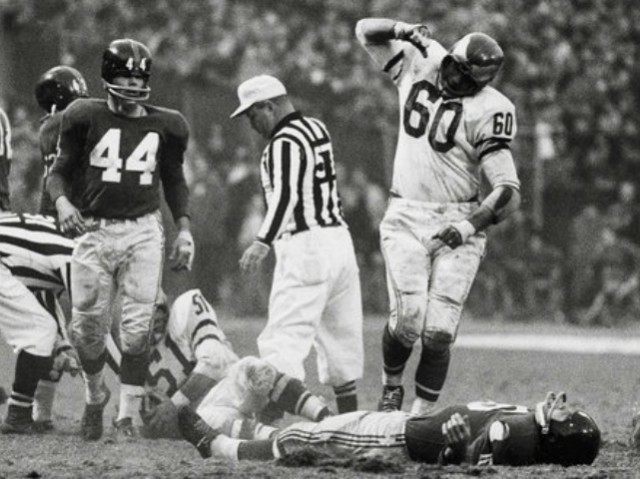Men on battlefields fell defending the flag. Millionaires on playing fields refuse to rise to honor the flag.
This rubs many Americans raw. It also represents an end-around of sorts on the tradition of football.
The first intercollegiate football game took place between Princeton and Rutgers four years after the last internecine battle of the Civil War. This did not occur by coincidence. Boys who missed the cutoff for the battlefield mimicked what they saw there on the playing field.
Football features the field general in the shotgun, the linemen in the trenches, and the receivers catching bombs. Designed plays, such as the flying wedge, drew their inspiration directly from military strategy. Martial music blares from the uniformed band. Decorations, in the form of chevrons for players and medals for soldiers, reward outstanding performance. Men in uniforms compete at Soldier Field, War Memorial Stadium, and other coliseums honoring men in uniforms.
The connection between the football and the armed forces long preexisted pregame national anthem rituals.
“Football IS war on a mimic scale and it will continue just as long as the nation is virile enough to fight,” observed Walter Camp, the closest thing to a football founding father, who developed a physical fitness routine at the behest of the federal government for soldiers during the First World War. The entire rosters of Harvard, Yale, and Princeton enlisted after America’s entry into the Great War. The commander in chief who took America to war never served in the military. He did serve as a football coach.
More than 600 NFL players left the league to join the military during World War II. Sid Luckman landed at Normandy as part of the U.S. Merchant Marine. Chuck Bednarik served as a tailgunner on thirty bombing missions over Europe. One team temporarily disbanded and several others combined squads to deal with the athlete exodus.
Paul Hornung got called to active duty during the height of his career on the Green Bay Packers. Hall of Famers Roger Staubach, Charlie Joiner, and Ray Nitschke served in the military during the Vietnam War. Rocky Bleier won a Bronze Star and Purple Heart before winning four Super Bowls as a running back for the Pittsburgh Steelers.
The booming business of professional football, and the absence of a draft, necessarily makes it unlikely that players ever again become soldiers in great numbers. That deserves a cheer and not a boo. But an unfortunate effect of this happy series of events means a lifestyle chasm between the players and fans of America’s Game. Many players cannot relate to normal people and many normal people cannot relate to them.
The disconnect between athletes and the spectators who cheer them on appears greater than ever. Few serve. Many disrespect those who do. Maybe the latter follows the former.

COMMENTS
Please let us know if you're having issues with commenting.